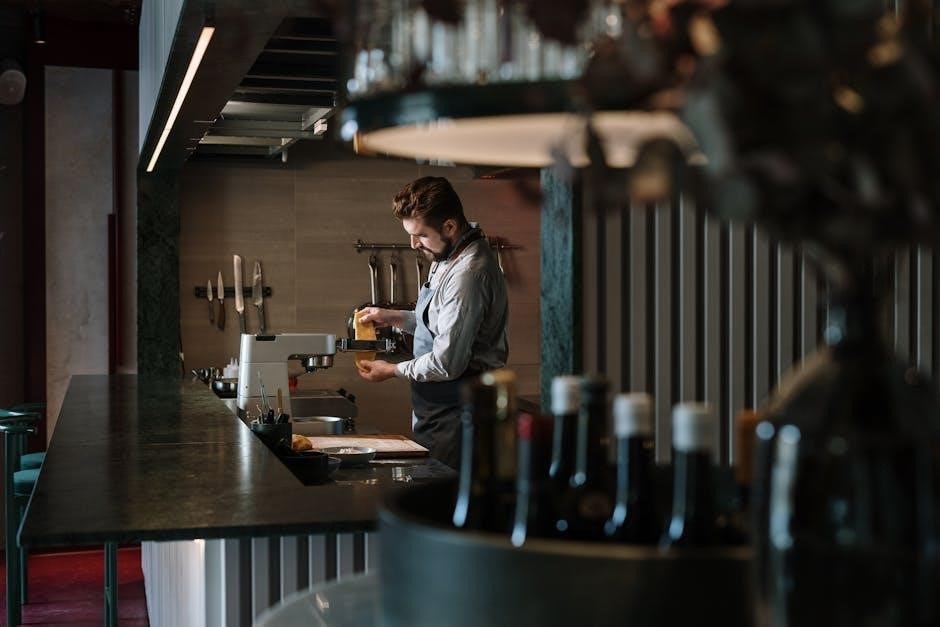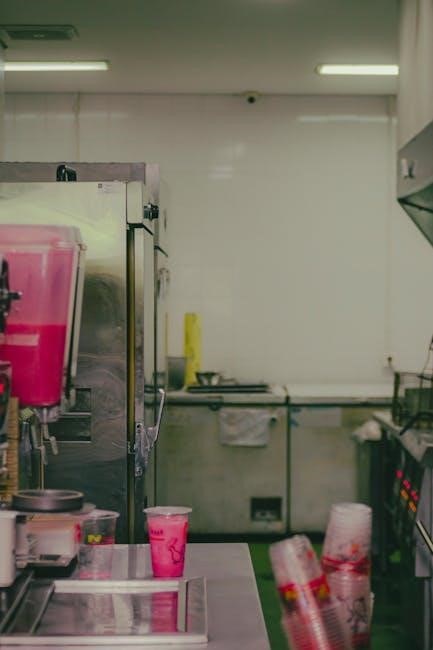A well-organized restaurant equipment list is essential for ensuring efficiency, consistency, and safety in food service operations, helping owners and managers streamline kitchen workflows and enhance customer satisfaction.
1.1. Importance of Restaurant Equipment
Restaurant equipment is the backbone of any food service operation, ensuring meals are prepared efficiently, safely, and consistently. High-quality equipment enhances productivity, maintains food quality, and supports staff performance. It also aids in adhering to health and safety standards, which are critical for customer satisfaction and operational success. Investing in the right tools not only streamlines workflows but also contributes to long-term cost savings and scalability, making it a cornerstone of a thriving restaurant business.
1.2. Purpose of a Restaurant Equipment List
A restaurant equipment list serves as a comprehensive guide to manage and track essential tools needed for daily operations. It helps in planning, budgeting, and purchasing, ensuring all necessary items are accounted for. The list also aids in maintaining organization, preventing shortages, and ensuring compliance with industry standards. By having a clear inventory, restaurants can optimize workflows, reduce downtime, and make informed decisions, ultimately improving efficiency and customer satisfaction.
1.3. Benefits of Having a Comprehensive Equipment List
A comprehensive equipment list offers numerous advantages for restaurant operations. It ensures efficiency by providing quick access to needed tools, reduces costs by preventing over-purchasing, and enhances safety by ensuring compliance with regulations. Additionally, it aids in staff training, allowing employees to familiarize themselves with available resources. By maintaining an organized inventory, restaurants can minimize downtime, streamline maintenance, and optimize resource allocation, leading to improved overall performance and customer satisfaction. This list is a vital tool for effective restaurant management.

Essential Kitchen Equipment
Essential kitchen equipment forms the backbone of any restaurant, enabling efficient food preparation, cooking, and storage. It ensures smooth operations, consistency, and safety, supporting high-quality food service delivery.
2.1. Cooking Appliances
Cooking appliances are the heart of any restaurant kitchen, enabling the preparation of a wide variety of dishes efficiently. These appliances include ovens, stoves, ranges, and microwaves, which are essential for cooking, heating, and reheating food. Commercial-grade appliances are designed to withstand heavy use, ensuring durability and consistent performance. They support various cooking techniques, from baking and roasting to frying and grilling, making them indispensable for achieving high-quality culinary results. Selecting the right cooking appliances is crucial for meeting menu requirements and operational demands.
2.2. Refrigeration Units
Refrigeration units are vital for maintaining food safety and freshness in a restaurant. They include walk-in freezers, reach-in refrigerators, and under-counter units, ensuring proper storage of perishables. These units help preserve the quality and shelf life of ingredients, preventing spoilage and contamination. Commercial-grade refrigeration systems are designed for heavy-duty use, offering precise temperature control to meet health and safety standards. Selecting the right size and type of refrigeration equipment is essential for efficient kitchen operations and food preservation needs.
2.3. Food Preparation Tools
Food preparation tools are essential for efficient kitchen operations, enabling chefs to chop, slice, mix, and prepare ingredients with precision. Key tools include knives, cutting boards, mixers, and graters. These tools enhance productivity, ensuring consistency and quality in food preparation. Manual tools like peelers and utensils are indispensable, while electric appliances such as food processors and blenders handle heavier tasks. Selecting durable, high-quality preparation tools is crucial for maintaining efficiency and delivering excellent culinary results, making them a cornerstone of any successful restaurant kitchen.
2.4. Baking Equipment
Baking equipment is vital for producing high-quality bread, pastries, and desserts in a restaurant. Essential tools include commercial ovens, mixers, dough rollers, and baking trays. These tools ensure precise temperature control and uniform baking, while large-scale mixers handle heavy dough preparation. Specialized items like proofing cabinets and pastry sheeters enhance efficiency for intricate baked goods. Durable and reliable baking equipment is crucial for maintaining consistency and quality in a fast-paced kitchen environment, making it indispensable for restaurants offering baked items.

Front-of-House Equipment
Front-of-house equipment includes items essential for creating a welcoming dining environment, such as dining furniture, lighting, and decor, ensuring a seamless and enjoyable customer experience.
3.1. Dining Room Furniture
Dining room furniture is crucial for creating a comfortable and inviting atmosphere. Tables, chairs, booths, and banquettes are essential, with materials ranging from wood to metal. Arrangement should prioritize space efficiency and accessibility, ensuring smooth customer flow. Comfortable seating enhances the dining experience, while durable designs withstand heavy use. Aesthetics also play a role, as furniture style contributes to the restaurant’s ambiance and brand identity, making it a key factor in customer satisfaction and repeat visits.
3.2. Point of Sale (POS) Systems
Point of Sale (POS) systems are essential for managing restaurant operations efficiently. They streamline transactions, process payments, and track orders. Modern POS systems offer features like inventory management, sales reporting, and customer data tracking. They also support integration with kitchen display systems and online ordering platforms. Choosing a user-friendly and scalable POS system ensures seamless operations, reduces errors, and enhances customer satisfaction. Additionally, POS systems provide valuable insights into sales trends, helping restaurants make informed business decisions and optimize their offerings.
3.3. Serving and Dining Ware
Serving and dining ware are crucial for enhancing the dining experience. This includes plates, bowls, utensils, and glassware, which must be durable, easy to clean, and visually appealing. Restaurants often opt for materials like porcelain, stainless steel, or melamine for their resilience. Additionally, serving trays, platters, and pitchers are essential for efficient food presentation. The choice of dining ware should reflect the restaurant’s theme and ambiance, ensuring consistency in style and functionality. Proper selection and maintenance of these items contribute to a positive customer experience and operational efficiency.

Cleaning and Maintenance Equipment
Cleaning and maintenance equipment are vital for maintaining hygiene, safety, and efficiency in a restaurant. This section covers essential tools and supplies needed for daily operations and upkeep.
4.1. Kitchen Cleaning Tools
Kitchen cleaning tools are essential for maintaining a hygienic and efficient workspace. Key items include heavy-duty mops, buckets, scrub brushes, sponges, and disinfectant sprays. Additionally, degreasers, dish scrubbers, and trash bags are vital for daily cleaning tasks. Specialized tools like pressure washers and steam cleaners can tackle tough grime and deep sanitation needs. Proper storage solutions, such as utility carts and storage bins, help keep these tools organized and easily accessible. These tools are crucial for preventing cross-contamination and ensuring a clean, safe environment for food preparation.
4.2. Dining Area Cleaning Supplies
Dining area cleaning supplies are crucial for maintaining a clean and welcoming environment for customers. Essential items include microfiber cloths, spray bottles, glass cleaners, and disinfectant wipes. Sanitizing solutions for tables, chairs, and menus are also vital. Floor cleaners and mops are necessary for keeping dining floors spotless. Additionally, trash bags, recycling bins, and odor-neutralizing sprays help maintain a fresh atmosphere. Organizing these supplies in utility carts or janitorial trolleys ensures they are easily accessible. These tools help create a hygienic and inviting space for diners.
4.3. Waste Management Equipment
Waste management equipment is vital for maintaining a clean and environmentally responsible restaurant. Key items include trash cans, recycling bins, and compactors for reducing waste volume. Sanitary bins are essential for disposing of food scraps and hazardous materials. Trash bags, waste shredders, and odor-neutralizing sprays also play a role. Additionally, dumpsters and waste sorting systems help streamline disposal processes. Proper waste management equipment ensures compliance with health regulations and promotes sustainability. Regularly maintaining this equipment is crucial for operational efficiency and a clean environment.

Specialty Equipment
Specialty equipment enhances menu offerings and operational efficiency, including grills, fryers, ice makers, and niche appliances. These tools allow restaurants to cater to diverse culinary needs and preferences effectively.

5.1. Grills and BBQ Equipment
Grills and BBQ equipment are essential for restaurants offering smoked, grilled, or charred dishes. Charcoal, gas, and electric grills provide versatility, while smokers add depth to meats. Accessories like BBQ utensils, brushes, and drip pans ensure efficient cooking. These tools help achieve consistent flavors and textures, making them indispensable for kitchens specializing in barbecue or grilled cuisine. Proper maintenance and safety features are crucial to prevent hazards and prolong equipment lifespan. Investing in high-quality grills enhances both menu offerings and customer satisfaction.
5.2. Fryers and Deep Fryers
Fryers and deep fryers are crucial for restaurants serving fried foods, ensuring crispy textures and consistent results. Commercial fryers come in countertop or floor models, with electric or gas options. Deep fryers are designed for large batches, while smaller fryers suit specific menu items like fries or doughnuts. Key features include temperature control, automatic shut-off, and easy cleaning. Durable construction and safety features, like cool-touch exteriors, are essential for busy kitchens. Regular maintenance, including oil draining and filter cleaning, is vital for longevity and hygiene.
5.3. Ice Makers and Crushers
Ice makers and crushers are essential for restaurants, bars, and cafes, providing fresh ice for beverages and desserts. Commercial ice makers come in under-counter, modular, and freestanding models, offering high production capacity and energy efficiency. Ice crushers, available in manual or electric designs, are perfect for creating crushed or shaved ice for cocktails, slushies, or frozen treats. Both units ensure consistent ice quality, durability, and ease of use, making them indispensable for maintaining customer satisfaction and operational efficiency in high-volume establishments.

5.4. Specialty Cooking Appliances
Specialty cooking appliances cater to unique culinary needs, enhancing menu versatility. Examples include pasta cookers, wok ranges, and sous vide machines. These appliances enable precise temperature control, consistent results, and efficient preparation of niche dishes. Ideal for restaurants offering specialized cuisines, they streamline operations and elevate food quality. Investing in these units allows chefs to experiment with innovative recipes while maintaining high standards of taste and presentation, making them invaluable for establishments aiming to stand out in competitive markets with distinctive culinary offerings.

Storage Solutions
Effective storage solutions are vital for maintaining organization, accessibility, and safety in a restaurant. They ensure ingredients, tools, and equipment are securely stored, protecting quality and reducing waste.
6.1. Shelving and Racks
Shelving and racks are essential for maximizing storage space in a restaurant; Adjustable shelving units allow for customizable storage of ingredients, cookware, and supplies. Heavy-duty racks, including dish racks and pan racks, provide sturdy solutions for organizing kitchen essentials. Open shelving is ideal for easy access to frequently used items, while enclosed units protect sensitive materials. Consider materials like stainless steel or wire for durability and ease of cleaning. Proper shelving ensures safety, efficiency, and quick access to what your team needs, streamlining kitchen operations.
6.2. Storage Containers
Storage containers are crucial for maintaining organization and hygiene in a restaurant. Airtight containers preserve food freshness and prevent contamination, while stackable options maximize space efficiency. Use clear, labeled containers for easy identification of contents like dry ingredients or cleaning supplies. Durable materials, such as food-grade plastic or stainless steel, ensure longevity and resistance to wear. Proper storage solutions help reduce waste, maintain inventory clarity, and support a clean, efficient kitchen environment, which is vital for smooth restaurant operations and staff productivity.
6.3. Pantry and Inventory Management
Effective pantry and inventory management ensures that all ingredients and supplies are organized, easily accessible, and used before expiration. Implementing a first-in, first-out system reduces waste and maintains freshness. Labeling shelves and containers clearly helps staff quickly locate items, while inventory tracking systems monitor stock levels. Regular audits prevent overstocking and ensure that essential items are always available. A well-managed pantry supports efficient cooking workflows, reduces costs, and enhances overall kitchen productivity, making it a cornerstone of successful restaurant operations.
Dining and Bar Equipment
Dining and bar equipment includes tables, chairs, bar stools, glassware, utensils, and appliances like blenders and mixers, ensuring a seamless dining experience for customers.
7.1. Bar Appliances
Bar appliances are crucial for crafting cocktails and serving beverages efficiently. Essential items include blenders, mixers, ice crushers, and wine coolers. Draft beer systems and cocktail shakers are also vital. These appliances ensure precise drink preparation and maintain the quality of beverages. Durable and easy-to-clean designs are preferred for high-volume use. Energy-efficient models can reduce operational costs while maintaining performance. Investing in quality bar appliances enhances the overall customer experience and streamlines bar operations. They are indispensable for creating a functional and inviting bar area.
7.2. Glassware and Barware
Glassware and barware are essential for serving beverages professionally. This includes highball glasses, rocks glasses, martini glasses, and wine glasses, as well as mugs for beer and shot glasses. Barware like jiggers, muddlers, shakers, and strainers are crucial for cocktail preparation. Durable, stylish designs enhance presentation and durability. Investing in quality glassware and barware ensures a polished look and functional service, elevating the bar experience for both staff and customers. Proper storage and maintenance are key to longevity and hygiene.
7.3. Beverage Dispensing Equipment
Beverage dispensing equipment streamlines drink service, enhancing efficiency and customer satisfaction. Key items include soda fountains, beer taps, coffee machines, juice dispensers, and water filtration systems. These units ensure consistent flavor and temperature control while reducing waste. Automated dispensers minimize manual effort, allowing staff to focus on other tasks. Customizable options, like flavored syrup dispensers, cater to diverse drink preferences. Durable materials and easy-to-clean designs make maintenance straightforward. Investing in high-quality beverage dispensing equipment elevates service quality and supports a seamless dining experience.
Energy Efficiency and Sustainability
Energy-efficient restaurant equipment reduces operational costs and environmental impact; Sustainable practices, like using LED lighting and eco-friendly appliances, promote green operations while maintaining high performance standards in kitchens.
8.1. Energy-Efficient Kitchen Appliances
Energy-efficient kitchen appliances are designed to minimize energy consumption while maintaining high performance. Examples include ENERGY STAR-certified ovens, induction cooktops, and steamers, which reduce energy use by up to 30%. These appliances not only lower utility bills but also contribute to a sustainable kitchen environment. By investing in eco-friendly equipment, restaurants can align with environmental trends and attract eco-conscious customers; Regular maintenance and smart usage further enhance their efficiency, ensuring long-term cost savings and reduced environmental impact.
8.2. Eco-Friendly Cleaning Supplies
Eco-friendly cleaning supplies are essential for maintaining a sustainable and safe kitchen environment. These products, such as biodegradable detergents and plant-based disinfectants, reduce environmental impact while effectively cleaning surfaces. They minimize harmful chemical exposure for staff and customers, promoting a healthier workplace. Restaurants can also benefit from certifications like Green Seal, which ensure the products meet high eco-standards. Using eco-friendly supplies supports corporate responsibility and aligns with growing consumer demand for sustainable practices, enhancing the restaurant’s reputation and compliance with environmental regulations.
8.3. Sustainable Storage Solutions
Sustainable storage solutions are crucial for reducing a restaurant’s environmental footprint. Eco-friendly containers, such as those made from recycled or biodegradable materials, help minimize waste and promote efficient food preservation. Reusable bins and shelving made from sustainably sourced wood or durable metals are excellent options. Proper storage also reduces food spoilage, aligning with waste reduction goals. Additionally, energy-efficient designs, like insulated containers, can lower energy consumption during refrigeration. Investing in sustainable storage supports long-term environmental responsibility and enhances a restaurant’s commitment to eco-conscious practices.
Safety and Compliance
Ensuring safety and compliance involves installing fire extinguishers, maintaining emergency exits, and adhering to health regulations to protect staff and customers while avoiding legal penalties.
9.1. Fire Safety Equipment
Fire safety equipment is crucial for protecting lives and property in a restaurant. Essential items include fire extinguishers, fire alarms, smoke detectors, and fire suppression systems. Restaurants must have Class K extinguishers for kitchen grease fires and Class ABC for general use. Fire blankets and emergency exit signs are also necessary. Regular inspections and staff training ensure equipment is functional and ready for emergencies. Compliance with local fire codes is mandatory to prevent hazards and legal issues, safeguarding both employees and customers.
9.2. First Aid and Emergency Kits
First aid and emergency kits are vital for promptly addressing injuries in a restaurant. Basic kits should include bandages, antiseptic wipes, gloves, and a first aid manual. Additional items like eye wash stations and burns kits are recommended for kitchens. Emergency kits should also contain flashlights, whistles, and evacuation plans. Regularly updating and restocking these kits ensures preparedness for accidents. Training staff in first aid procedures enhances response effectiveness, minimizing risks and ensuring a safe environment for both employees and patrons during emergencies.
9.3. Regulatory Compliance Equipment
Regulatory compliance equipment ensures adherence to health, safety, and food safety standards. Essential items include food thermometers, HACCP systems, and data loggers for temperature tracking. Health inspection tools, such as test strips for sanitizers, are crucial. Proper signage, like allergen warnings and exit signs, is also mandatory. Documentation tools, such as record-keeping binders, help maintain compliance records. Investing in these ensures smooth operations, avoids legal issues, and builds customer trust by demonstrating commitment to safety and regulatory adherence in daily restaurant operations and food preparation processes.

Additional Considerations
Additional considerations include optimizing equipment layout for efficiency, ensuring staff safety, and planning for future growth, all while balancing budget constraints and long-term operational goals effectively.
10.1. Staff Training on Equipment Usage
Proper staff training on equipment usage is critical for safety, efficiency, and maintaining equipment longevity. Regular hands-on sessions ensure employees understand operational procedures and safety protocols. Comprehensive training programs should cover equipment functionality, maintenance, and troubleshooting. This not only enhances workplace safety but also improves overall kitchen performance. Additionally, training fosters confidence among staff, leading to better customer service and a more streamlined workflow. Regular updates on new equipment or techniques keep the team informed and adaptable to changes in the restaurant environment.
10.2. Maintenance and Repair Services
Regular maintenance and prompt repair services are vital to extend the lifespan of restaurant equipment. A well-planned maintenance schedule helps prevent unexpected breakdowns, ensuring smooth operations and food safety. Daily, weekly, and monthly checks should be conducted, with a focus on high-use items like ovens and refrigerators. Keeping an inventory of spare parts and having a reliable repair service on call can minimize downtime. Additionally, hiring certified technicians ensures that repairs are done correctly, maintaining equipment efficiency and compliance with safety standards. Preventive maintenance programs are key to avoiding costly repairs and ensuring long-term functionality.
10.3. Budgeting for Equipment
Budgeting for restaurant equipment requires careful planning to balance quality, functionality, and affordability. Start by prioritizing essential items based on your menu and operational needs. Consider both upfront costs and long-term expenses, such as energy consumption and maintenance. Allocating funds for energy-efficient appliances can reduce utility bills over time. Additionally, set aside a contingency budget for unexpected repairs or upgrades. Regularly reviewing and updating your budget ensures you stay on track and can adapt to evolving business needs or advancements in technology.
A well-curated restaurant equipment list is vital for ensuring efficiency, safety, and customer satisfaction, making it an indispensable tool for every successful food service establishment.
11.1. Final Thoughts on Restaurant Equipment
Investing in the right restaurant equipment is the cornerstone of a successful food service operation. It ensures efficiency, consistency, and safety, directly impacting customer satisfaction and loyalty. Balancing quality and cost is crucial, as the right tools enhance workflows while staying within budget; Staying informed about industry trends and innovations helps restaurants adapt to changing demands. Ultimately, a well-equipped kitchen and dining area foster a positive experience for both staff and patrons, driving long-term growth and success in the competitive culinary industry.
11.2. Importance of a Well-Equipped Restaurant
A well-equipped restaurant ensures smooth operations, consistency in food quality, and adherence to safety standards. It enhances efficiency, reducing wait times and improving customer satisfaction. Proper equipment also supports staff performance, as they can work more effectively with the right tools. A well-equipped kitchen and dining area create a positive reputation, attracting repeat business and fostering long-term success. Investing in quality equipment is a cornerstone of building a thriving and sustainable restaurant business that meets customer expectations and industry demands;
11.3. Future Trends in Restaurant Equipment
Future trends in restaurant equipment focus on smart, energy-efficient, and sustainable solutions. Automation, such as smart appliances and robotic kitchen assistants, will streamline operations and reduce labor costs. Internet-connected devices will enable real-time monitoring and maintenance, improving efficiency. Eco-friendly equipment, like energy-efficient ovens and waste-reducing tools, will gain popularity. Additionally, modular and multi-functional designs will cater to evolving menu trends and space constraints. These advancements aim to enhance customer experience, reduce operational costs, and align with environmental and technological advancements shaping the future of the foodservice industry.

How to Use This Equipment List PDF
This guide provides a comprehensive overview of essential restaurant equipment, helping you organize and optimize your kitchen setup for maximum efficiency and success.
12.1. Navigating the PDF Guide
This PDF guide is structured to help users easily find and categorize restaurant equipment. Each section is clearly labeled, allowing quick access to specific categories like kitchen appliances, front-of-house items, and cleaning tools. The logical flow ensures that users can move seamlessly from planning to implementation. Features like bookmarks and an index enhance navigation, making it simple to locate particular equipment or sections. This organized approach helps restaurant owners and managers efficiently utilize the guide to meet their establishment’s needs.
12.2. Customizing the List for Your Restaurant
Customizing the equipment list to fit your restaurant’s unique needs is crucial for optimal functionality. Start by reviewing the PDF guide and identifying essential items based on your menu, kitchen size, and staff requirements. Adjust quantities or remove unnecessary equipment to tailor the list to your specific operations. Consider factors like cuisine type, dining style, and customer volume to ensure relevance. Prioritize must-have items and mark optional ones for future consideration. This personalized approach ensures the list aligns with your restaurant’s goals, enhancing efficiency and cost-effectiveness.
12.3. Sharing the Guide with Your Team
Sharing the equipment list PDF with your team is crucial for ensuring everyone is aligned and informed. Distribute the guide to chefs, managers, and staff, highlighting key sections relevant to their roles. Schedule a meeting to review the list collectively, allowing time for questions and clarifications. This fosters collaboration and ensures smooth operations. Encourage feedback and suggestions to refine the list further. Regular updates keep the team informed about new equipment or procedures, promoting efficiency and consistency. Involving your team in the process enhances accountability and shared responsibility for maintaining high standards.
